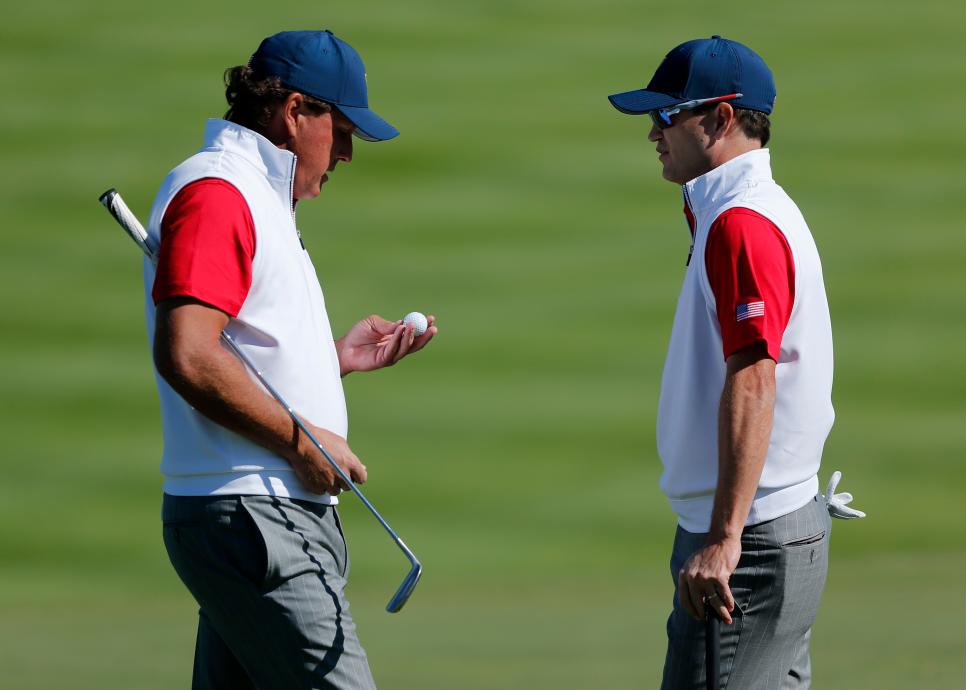The Loop
Still confused by the Phil Mickelson ruling? Let's break it down point by point
Phil Mickelson’s screw-up regarding the one-ball rule not only was somewhat bizarre, but an example of how the Rules of Golf can be nuanced enough to where even the best players in the world -- and, in this case one of the game's most respected rules officials -- botch them on one of golf's biggest stages. Moreover, it has left many scratching their heads wondering exactly what happened and why. For you rules junkies out there, let's try to answer some of those questions.

AP
Why did Mickelson have two different types of balls in his bag and how did he not know the rule?
Mickelson carried two models of his Callaway ball, including a firmer version that he felt he could get more distance with. He had them in the bag because he believed there was no one-ball rule in effect.
Why would he think that?
At the Presidents Cup, there is no one-ball rule for foursomes (alternate shot). So in playing on Thursday, he and Zach Johnson freely switched between holes. Lefty assumed that applied for the entire event, which was a mistake on his part. In four-ball and singles, the one-ball rule applies.
So why only in foursomes and not the other two formats?
According to Missy Jones, a USGA official, the general idea behind not having a one-ball condition in foursomes is that there is a likelihood the two players might normally play different balls and they want to protect the players from the possibility of an inadvertent penalty for breaching the one-ball rule. In four-ball and singles, there is less likelihood of that since players are using their own ball. Jones did add, however, that some state golf associations have gone away from the one-ball rule entirely in order to eliminate such penalties.
OK, so Mickelson and his partner deserved the penalty. But why were they penalized two holes on one hole?
That’s a misnomer. What happened was that the penalty for violating the one-ball rule in match play is an adjustment to the state of the match by one hole. So basically a one-hole penalty. But Johnson and Mickelson also lost the seventh hole via their own play. So it appeared it was a two-hole penalty when in fact it was only one.
But Mickelson was disqualified from the hole.
That was a HUGE mistake on the part of match referee Gary Young and the rules committee, including veteran PGA Tour rules official Mark Russell. Young consulted with the committee who wrongly informed him that Mickelson was disqualified from the hole. So Lefty picked up his ball. Over the course of the next few minutes, the committee realized its error, but since other players in the match had hit they could not correct the mistake under Decision 34-2/6 of the Rules of Golf. As Russell said, "This is because once any player in the match plays a subsequent stroke, allowing a correction could potentially undermine the strategy already employed by both sides in the match in completing the hole."
So, in theory, they could have lost only one hole or possibly none if the rule had been applied correctly.
Yes. Had the Mickelson-Johnson team halved the hole they would have only lost the one-hole adjustment penalty. Had they actually won the hole, it would have offset the one-hole adjustment and the match would have still been all square.
This is the first time I’ve heard of a "match adjustment." What other examples are there for when a match would be adjusted?
Rule 30-3d (penalty to a side in best-ball or four-ball match play) is fairly clear. A side is penalized for a breach of the following by any partner: Rule 4 (clubs), Rule 6-4 (caddies), any Local Rule or Condition of Competition for which the penalty is an adjustment to the state of the match. A couple examples:
At the conclusion of a hole in which any partner started with more than 14 clubs, the state of the match is adjusted by deducting one hole for each hole at which a breach occurred, with a maximum deduction of two holes per round. So if on the first hole, a partner is discovered to have more than 14 clubs, that side would have a one-hole deduction implemented to the score, regardless of the outcome of the hole. Meaning, if the side with the golfer who carried more than 14 clubs won that hole, that result would stand and then that side would suffer a one-hole deduction from its score.
Another example where a one-hole deduction could come into play is the use of multiple caddies at any one time in match play. You’re only allowed one per round. Again, the result of the play of the hole where the violation occurred would stand, regardless of whether it was won, lost or halved by the penalized side. However, at the conclusion of the hole, that side would be hit with a one-hole deduction. This maximum deduction is still two holes per round.

